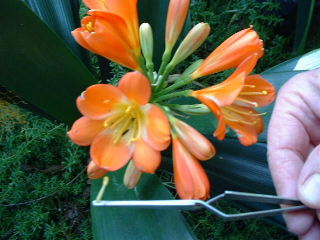CliviaNet: Growing Clivia in Cold Climates
Pollinating
All clivia enthusiasts hand pollinate, and must decide what to use. Dabbing with fingers is clumsy and wasteful and use of a fine brush works well, but in both cases clean-up between every pollination is essential but time-consuming. Ordinary tweezers can also be used, but the grip must be maintained otherwise the anther falls and is lost.

In the mid 90s we were struck by the idea of using reverse tweezers (photo), obtainable from the electronics industry, and many local enhusiasts now use this method. The advantage is that it is easy to break of a filament and on releasing pressure the single anther is securely held and can easily be used on a number of flowers. Being smooth steel, there is no problem with wiping them clean between pollinations.
Connie and James Abel, Pretoria, South Africa
Timing of pollination can also be important. I have generally good luck hand-pollinating C. miniata cultivars and varieties. I had a very good seed crop hand-pollinating C. nobilis X nobilis, too. I use the tweezers and stamen method when fresh pollen is available. When using stored (frozen) pollen, I use a fine artist's brush. It is well to remember that for most flowers in the Amaryllis Family (Amaryllidaceae), the pollen ripens ahead of the stigma. So take pollen from freshly opening flowers and apply it to stigmas of flowers that have already been open for a day or two or three. You can keep re-applying fresh pollen to that same old stigma until the stigma begins to turn a bit darker.
Jim Shields, Indiana (USA)
Pollen of Clivia as well as that of most other plants in the Amaryllis Family, the Amaryllidaceae, can be stored for extended periods of time and still retain useful viability. For more information on storing pollen, see: ![]()